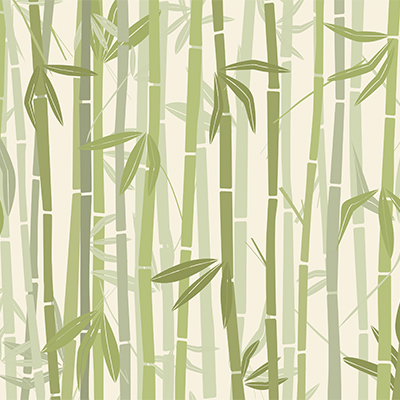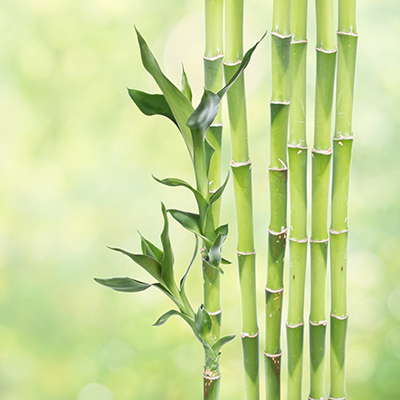
29 Jan The social fabric: the new cut for bamboo textiles
Article by Gaayathri Periasami of Baby Peppers
Bamboo is undeniably one of the most, if not the most sustainable plant on earth. It’s the fastest-growing plant in the world, requires very little water for growth, grows organically with no pesticides needed, and regenerates constantly. It can’t get more sustainable than this. However, the bamboo textile production process is a different story and fraught with some complexities.
Typically, there are two methods used when manufacturing bamboo textiles: the mechanical and the chemical. The mechanical method is very labour intensive and prohibitively expensive but requires no chemicals or fungicides. Bamboo fibres are raked and combed into long strands and drawn out and spun into a yarn. This process is similar to producing linen from flax. The chemical process is the one that causes grave environmental and health concerns with many researchers claiming that the production method dates back to the 1800s without any real consideration to the planet or the workers involved in the process. This process turns bamboo into yarn by cooking the bamboo plant in strong chemical solvents to create a viscose solution. This solution is reconstructed into a cellulose fibre which is then spun into yarn to create textiles or fabrics.
I won’t dismiss these complexities as being unethical straight away. Any hard claim needs ample research and data to substantiate and even then, nothing is 100%. The truth is that textiles derived from bamboo pulp are nothing more than rayon fibres created chemically. To obtain that ethereal softness of bamboo fabrics, the chemical process uses sodium hydroxide and carbon disulphide, to break down the bamboo. Bedding giant, REST, in the United States uses research-enhanced sleep technology to manufacture their bedding products and have done extensive research into the use of bamboo fibres in their manufacturing process. The corporation states that the cellulose making process for bamboo, when used responsibly has absolutely no effect on the environment and workers’ health. In fact, it is routinely used in the processing of organic cotton into fibre and is approved by the Global Organic Textile Standards (GOTS) and the Soil Association. It is also widely used in everything from soap production to food preparation.
 I’m not saying green washing is acceptable and that bamboo should be sold as the be all and end all to fabrics, but what I do like you to do is pause and reflect to opine on something with appropriate context. For instance, is it fair to state that a social enterprise that sells bamboo textiles and makes a difference in the lives of its artisans by giving them fair trade wages, safe working conditions and equal employment opportunities, is more unethical than the owner of the Rana Plaza building who consistently ignored the pleas of the workers to repair the dilapidated conditions, causing a monumental tragedy? Are we measuring that 1,200 deaths through unsafe working conditions is better than working with a chemical process that may or may not be harmful to the workers depending on how the process is handled? Many enterprises and individuals who love bamboo textiles have not stopped in their quest to find the safest and most eco-efficient way to produce the fabrics. Brilliant material scientist Dr. Tarannum Afrin has developed a method of extracting the fibres in a more pure, eco-efficient way to make genuine bamboo textiles retaining the qualities of bamboo. Her time as a research scholar at the Deakin University from 2009 to 2012, earned her significant media attention because of her breakthrough research work in bamboo fibre. The process she developed allowed the processing of the bamboo plant into a fibre in an environmentally friendly way while retaining the UV qualities, the wicking, and anti-bacterial properties. Dr Afrin has always maintained her position that bamboo is a promising alternative to other natural fibres like cotton and silk which are labour and resource intensive. She does hope that the environmentally friendly method of extracting the fibres from the lignin will revolutionise the bamboo fibre industry and silence the critics.
I’m not saying green washing is acceptable and that bamboo should be sold as the be all and end all to fabrics, but what I do like you to do is pause and reflect to opine on something with appropriate context. For instance, is it fair to state that a social enterprise that sells bamboo textiles and makes a difference in the lives of its artisans by giving them fair trade wages, safe working conditions and equal employment opportunities, is more unethical than the owner of the Rana Plaza building who consistently ignored the pleas of the workers to repair the dilapidated conditions, causing a monumental tragedy? Are we measuring that 1,200 deaths through unsafe working conditions is better than working with a chemical process that may or may not be harmful to the workers depending on how the process is handled? Many enterprises and individuals who love bamboo textiles have not stopped in their quest to find the safest and most eco-efficient way to produce the fabrics. Brilliant material scientist Dr. Tarannum Afrin has developed a method of extracting the fibres in a more pure, eco-efficient way to make genuine bamboo textiles retaining the qualities of bamboo. Her time as a research scholar at the Deakin University from 2009 to 2012, earned her significant media attention because of her breakthrough research work in bamboo fibre. The process she developed allowed the processing of the bamboo plant into a fibre in an environmentally friendly way while retaining the UV qualities, the wicking, and anti-bacterial properties. Dr Afrin has always maintained her position that bamboo is a promising alternative to other natural fibres like cotton and silk which are labour and resource intensive. She does hope that the environmentally friendly method of extracting the fibres from the lignin will revolutionise the bamboo fibre industry and silence the critics.
I also researched and trawled through multiple websites to verify if anyone has died from bamboo fabric production or been grievously injured or harmed by the chemical process. I couldn’t find anything credible to prove this. Although some sites claimed that carbon disulphide has caused neural disorders in workers at rayon manufacturers, there is no solid evidence presented with dates, locations or numbers.
Today, there are many aggressive textile lobbyists claiming that any business that uses inorganic cotton or bamboo is unethical and should be boycotted. This is such a broad, generalised statement and one that deeply saddens me. The level of ignorance this statement embeds is staggering. There are many large companies that use organic cotton or avoid bamboo, but their supply chains are ridden with corruption and disgruntled workers who are treated appallingly. How does this make them ethical just because they use a particular type of fibre or textile? What about the socially impactful businesses that use inorganic cotton and bamboo fabrics, but their supply chains are all about honesty, fair wages and transparency? Organic textiles do not necessarily translate to being eco-friendly or sustainable (organic cotton only means the original plant was grown without pesticides, but it is still a water-intensive crop). Likewise, ‘sustainable’ may not equate to eco-friendly. At the 2011 International Federation of Organic Agriculture Movements (IFOAM), Ann Shankar from Biodye India, a company that produces natural dyes based on wild plants, made a bold claim that the term ‘organic textile is not an accurate description of any textile where synthetic dyes and auxiliaries are used. There is indeed some truth to this claim. Textile production is only one aspect. The supply chain of a production factory encompasses a hundred aspects – from working conditions, to staff wellbeing, to safety standards amongst many more. Yet, there is somehow a misaligned notion that bamboo textile production with sulphuric acid trumps all the other atrocities in a textile factory. To make a fully informed decision based on your beliefs and values, you need to take apart and analyse the entire process chain and look for independent certifications for any claims.
 Companies like O-Ecotextiles go to great lengths to ensure that the source of the bamboo and the textile production is not harmful. The bamboo used in their clothing line does not impact panda habitats and the bamboo is sent to their Japanese yarn manufacturer who uses bacteria and enzymes to sequester and neutralise the sulfuric acid during the viscose making process. This returns the wastewater to the ecosystem and the water quality meets stringent Japanese drinking water standards. This shows that bamboo textile production can indeed be done with minimal environmental impacts.
Companies like O-Ecotextiles go to great lengths to ensure that the source of the bamboo and the textile production is not harmful. The bamboo used in their clothing line does not impact panda habitats and the bamboo is sent to their Japanese yarn manufacturer who uses bacteria and enzymes to sequester and neutralise the sulfuric acid during the viscose making process. This returns the wastewater to the ecosystem and the water quality meets stringent Japanese drinking water standards. This shows that bamboo textile production can indeed be done with minimal environmental impacts.
Swiss technology giant Litrax, a state-of-the-art corporation that provides advanced, innovative and environment-conscious nanotechnology to create highly functional textiles, has created cutting edge solutions to combat challenges in the bamboo textile process. The corporation is working to refine the lyocell process which uses N-methylmorpholine-N-oxide (NMMO) to dissolve the bamboo cellulose into a viscose solution. The process is closed-loop where 99.5 % of the chemicals used during the processing are captured and recycled. No waste is created, with only minimal amounts escaping into the air. The process is considered to be one of the leading methods of producing environmentally friendly regenerated fibres for bamboo textiles.
The benefits of bamboo textiles are ample. Bamboo is a resilient and durable, allowing the fabric for multiple washes while still retaining its incredible softness. It has also been found have better moisture wicking and absorption properties, is hypoallergenic, breathable, thermo-regulating and biodegradable, amongst other benefits. Bamboo grows very densely and its ability to flourish in diverse climates from cold mountains to hot tropical regions makes it a highly versatile and sustainable resource. It can slow deforestation and over 1600 species of bamboo can be found across 100 million acres of the earth, mostly in Asia. Bamboo is also extremely efficient at minimising carbon dioxide and generates up to 35% more oxygen than other kinds of trees. One hectare of bamboo can sequester 62 tonnes of carbon dioxide per year – what an amazing form of carbon sink!
It’s certainly hard to dismiss sustainable land use practices that provide economic and environmental benefits and now more than ever, there is a global need to preserve our common home. As every one of us in the world compete for water, food, clothing and shelter, the high yield of bamboo becomes a very significant advantage.
*************************************
The opinions expressed by the contributors to the blog and those providing comments are theirs alone, and do not reflect the opinions of ArtWear Publications or any of its employees. Artwear Publications is not responsible for the accuracy of any of the information supplied by the contributors or those providing comments.


No Comments